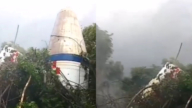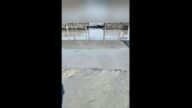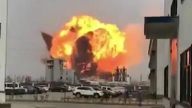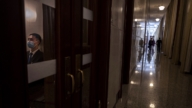【新唐人2014年06月06日讯】中共环保部6月4号发布《2013中国环境状况报告》,报告说,依据新的“环境空气质量标准”,去年中国74个城市中,仅3个城市的空气质量达标,而10个空气最差的城市,有7个在河北。
6月5号是“世界环境日”。中共环境保护部官员4号表示,大陆去年的空气质量,京津冀、长三角、珠三角三大重点区域的74个城市中,仅海口、舟山和拉萨3个城市达标。而去年全中国雾霾日数平均有35.9天,比上年增加18.3天,为1961年以来最多。
早在今年的1月10号,国际非政府组织“绿色和平”,已发布了中国74 个城市2013年的PM2.5年均浓度排名。
“绿色和平”的这项排名显示,中国的空气污染问题在长三角地区日趋严重,中西部省份也凸显出空气污染的问题。
而在实施《环境空气质量标准》监测的这74座城市中,空气PM2.5悬浮粒子的年均浓度,有近92%的城市达不到国家标准,其中32座城市的PM2.5年均浓度是国家标准的2倍以上。而排行前十名的城市,PM2.5年均浓度几乎是国家标准的3倍以上,其中有7个城市位于河北省。
特别是排在前两位的河北邢台、和石家庄的年均PM2.5浓度,是国家标准的4倍以上。
而美国的调查指标显示,去年北京仅有13天空气质量良好。
“绿色和平”组织东亚气候和能源活动家方立峰曾经表示:中国已有数百万的人口,面临着一年有三分之一天的重度污染空气。另有一些地区,一年12个月,几乎没有好空气。
美国《外交政策》杂志6月4号报导说,四月份一份官方研究发现,近十分之一的中国农田被污染,还有五分之三的中国地下水被污染。
中共环境保护部官员在4号的《中国环境状况报告》发布会上表示,将努力打好“向污染宣战”的所谓“三大战役”,也就是﹕大气污染防治、水污染防治,和土壤污染防治。
北京水污染环保自愿者张峻峰﹕“我们并没有认清楚产生这些空气、水和固体污染的一些状况的基本原因是什么。在没有认清楚的状况之下,就提出这样的目标,实在是有些盲人摸象的一种状况。”
中国财经、社会问题评论家巩胜利﹕“你刚才讲到这个环境问题、水、土、空气,这是中国自己的事情当然要中国自己来做,但是,没有老百姓的参与,没有全体公民的参与,光是你官方自己上,我觉得可能也是非常难的难点。没有它的制衡,没有相反的意见,或者没有科学技术、理论的争论,或者是权衡,可能会出现误差,或者是适得其反。”
中国财经、社会问题评论家巩胜利提出,中共最高层的决策,包括三峡水利工程,和文化大革命、大跃进、三反、五反,实施结果却是天怒人怨,成为人类的灾难。这次中共“向污染宣战”,特别需要科学来论证。
《外交政策》的报导说,由北京及中国东北美侨商会进行的调查发现,48%的受访者表示,由于污染问题,难以在中国招聘或留住高级主管。
去年10月,中国东北的大部分地区都被浓密的雾霾覆盖,包括黑龙江、吉林、辽宁等省分。黑龙江哈尔滨市机场被迫关闭,两千多所学校停课。雾霾也导致黑龙江省境内多条高速公路被迫关闭。
英国《金融时报》在今年早些时候的一篇报导中,用“空气末日”(Airpocalypse)来形容北京的雾霾天气。报导说,日益恶化的污染问题,促使一些在华工作的外籍人士,提前离开中国,增加了外国企业在华投资成本。
据“绿色和平”组织发布的一项调查显示,基于中国政府给出的PM2.5数据显示,空气污染增加了肺癌和心脏衰竭的病发率。
张峻峰﹕“像我们现在所遇见的所有的社会问题,甚至于包括新疆的问题,或者对社会进行报复的这样一些事件,都和我们的经济发展模式息息相关,而不是毫无关联的。如果认识到这一点,或者从这个角度,来认识我们当今社会问题的话,可能污染问题才有可能得到缓解,或者往缓解的方向在迈进。”
“世界卫生组织”驻中国代表今年2月表示,中国城市的空气污染问题,应该被视为“危机”来处理。
采访/朱智善 编辑/周平 后制/钟元
Seven of Top Ten Most Polluted Chinese Cities Are In Hebei Province
The Pollution Report 2013 was released by China
Ministry of Environmental Protection on June 4.
According to the report, only 3 out of 74 Chinese
cities measured met new air quality standards.
Among the 10 worst cities for air quality,
seven of them are located in Hebei Province.
June 5 is World Environment Day.
The Chinese authorities released their
report, indicating that last year, only Haikou,
Zhoushan and Lhasa met air quality standards.
The report surveyed a total of 74 cities,
including Beijing, Tianjin, cities in Hebei,
the Yangtze and Pearl River Deltas.
Smog days were averaged 35.9 days last year,
which is an 18.3 day increase from last year.
This is the most severe occurence since 1961.
On January 10, international NGO Greenpeace released
it’s rankings for the air quality of 74 Chinese cities in 2013.
This was based on average annual
particle pollution concentrations, or PM2.5.
The Greenpeace rankings showed the Yangtze
River Delta region was the hardest hit area.
Western provinces showed
emerging issues in air pollution.
In the monitoring program Ambient Air Quality Standards,
92% of cities failed to meet the state standard of PM2.5.
Thirty two cities had twice the limit of the PM2.5.
The top 10 worst air cities had three
times the minimum level of PM 2.5.
Seven of these cities are located in Hebei.
In particular, Xingtai and Shijiazhuang had an annual
PM2.5 concentration of four times that of the minimum.
The U.S. survey showed that there were only
13 days last year that had good air quality in Beijing.
Greenpeace East Asia climate and energy campaigner
Fang Lifeng has commented that Millions of Chinese
are facing severe air pollution for one third of a year.
Some areas rarely have any good air for the entire year.
Foreign Policy magazine’s recent report
indicates that, nearly one-fifth of farmland is
polluted, an official government study found in
April, and so is three-fifths of China’s groundwater.
In a recent press release for the Pollution Report
2013, Chinese officials indicated that they will strive
in the battle to control pollution of air, water, and soil.
Zhang Junfeng, environmentalist, Beijing: “We have not
had a clear understanding of the cause of the pollution.
The official claims for anti-pollution actions are pointless.”
Gong Shengli, commentator: “Speaking on the
issue of pollution in water, soil and air, of course
the Chinese populace need to take care of it.
Without the participation of the people,
the claims of the official makes it hard.
It takes a check and balance of the policies,
ideas and debates in science and technology.
Otherwise, the effect will be counterproductive.”
Commentator Gong Shengli highlights past examples
of the Chinese regime’s actions and decisions;
the Three Gorges Dam, the Cultural
Revolution, and the Great Leap Forward.
All have only resulted in outrageous
results and caused human catastrophes.
He stresses the official battle against
pollution is in need of scientific proof.
A recent survey by the Beijing and Northeast China
chapters of the American Chamber of Commerce found
that 48 percent of respondents “cited difficulty recruiting
or retaining senior executives in China due to pollution.”
This is what was reported in Foreign Policy.
Last October, thick haze covered
most parts of northeast China.
This includes Heilongjiang, Jilin,
Liaoning and other provinces.
The Airport and more than 2,000
schools were forced to close in Harbin.
Haze has also forced Heilongjiang
Province to close a number of highways.
The Financial Times has reported earlier this year that the
Airpocalypse in Beijing has forced foreign executives to leave
China earlier and increased the cost in the investment in China.
The Greenpeace survey also indicated higher lung
cancer and heart failure rates as a result of air pollution.
This was based on the PM2.5
data from the regime officials.
Zhang Junfeng: “It is like all of the social
problems we have encountered.
Everything is closely related to our
model of economic development.
Only by recognising this will we step towards relieving
the issues in social problems, as well as in pollution.”
The World Health Organization representative
in China said in February this year that urban
pollution in China should be dealt with as a “crisis".
Interview/Zhuzisan Edit/Zhoupin Post-Production/Zhongyuan





























